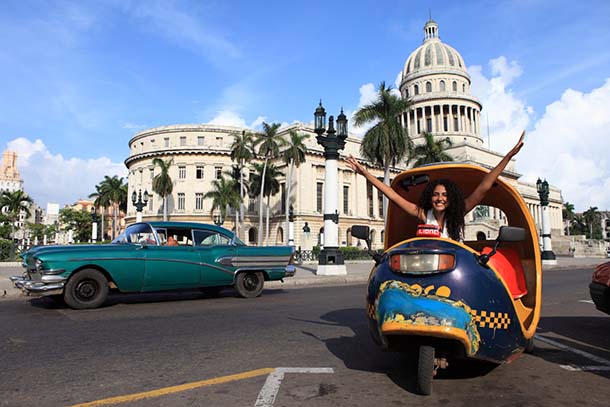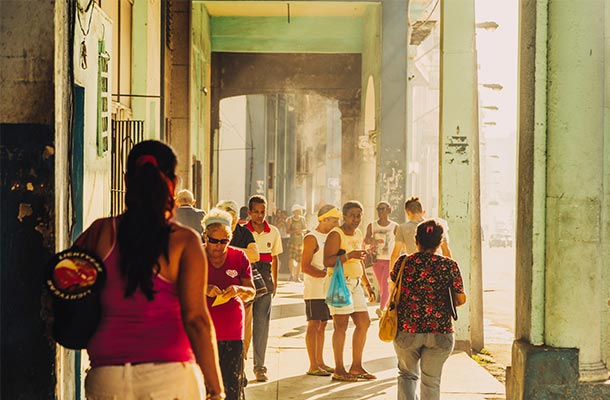Transport in Cuba: How to Travel Around Safely
Before you hop into that very old collectivo or a coco taxi in Cuba, here's everything you need to know about safe modes of transport.
 Photo © iStock
Photo © iStock
Cuba is the largest of the Caribbean islands, but perhaps one of the most important parts of planning a trip to Cuba is figuring out how you'll get around once you're there.
Here are the essential things you need to know before you navigate the country.
Transport options in Cuba
By car
Renting a vehicle in Cuba is relatively easy and common among travelers. But, there are a few things to keep in mind if you want to stay safe on the roads.
By most accounts, driving in Cuba can be rough. This is due to poor conditions on many secondary roads, which can be narrow, winding and riddled with potholes. Add to this the lack of adequate street signage and you've got a confusing and potentially dangerous situation.
Driving at night can be particularly risky since many roads are poorly lit (or not lit at all). Additionally, it's not uncommon to come around a bend and find pedestrians, bicyclists or even livestock in the road, so drivers should exercise caution.
Another thing to look out for is traffic lights, which are often placed to the far corner of intersections. This can be hazardous because if you're not expecting to come upon one, you may find yourself stopped dangerously in the middle of the crossing.
Pay attention to where you need to stop or you'll be an accident waiting to happen. One of the leading causes of accidental death in Cuba is motor vehicle accidents, so be aware and be careful.
If you do happen to be involved in a car accident, even if you are not at fault, you will most likely be detained in Cuba until the case is resolved. Not exactly the ideal circumstances under which to extend your stay.
By taxi
Knowing the dangers of actually getting behind the wheel in Cuba, it's not surprising that many tourists choose to use taxis to get around instead. There are certainly plenty available for hire, but should you choose this particular mode of transportation, take into account the following so that you do so safely. First and foremost, avoid taking rides with unlicensed taxis.
They are often driven by thieves who are out to pick up and rob passengers. Be particularly careful of fare amount when hiring a taxi, especially in Havana.
If possible, ask someone who is native or at least familiar with the system how much the fare should be prior to heading to your destination. This way you will know beforehand how much the driver should be charging you and can avoid be scammed out of an exorbitant fee by a dishonest driver.
If you can't confer with a local, insist that the meter be used to remove any doubt.
One of the more unique types of transportation in Cuba is the "coco" taxi, a three-wheeled vehicle that is generally yellow in color and contains a flimsy hood. These are basically just glorified motorcycles that have been modified to carry passengers.
Because they can reach speeds of up to 40mph and lack any sort of safety features, including seatbelts, "coco" taxis can be pretty dangerous.
They are, nevertheless quite popular with tourists so if you choose to ride on one, be aware of the risk.
By bus
There are a number of options when it comes to bus travel within Cuba. Many are specifically designated for tourists and travel conveniently within and between cities, such as Viazul.
This mode of transportation is pretty reliable and clean, although some of the more heavily used buses are beginning to show their wear.
One thing to keep in mind when selecting buses as a mode of transportation is that they can be quite crowded and therefore can be haven for pickpockets. Keep your valuables well concealed and bags zipped and stored in front of you, just in case.
By train
Travel by train is not the most reliable form of transportation in Cuba, mainly due to the lack of quality equipment. Still, there are a few dependable train lines that run between Havana and Santiago de Cuba.
There are also additional lines throughout the country with stops at Camagüey, Santa Clara, and the cities of Manzanillo, Cienfuegos, Sancti Spiritus, Pinar del Rio and Morón. Keep in mind that while a few trains offer first-class options, none of them provide sleeper cars.
Additionally, food and drink are not typically served so plan accordingly. With the poor equipment quality of many of the trains, you may find yourself stuck for hours awaiting the car's repair. And while aboard, be sure to keep a close eye on your belongings. Luggage is frequently stolen from train cars in Cuba.
Hitchhiking (El Amarillo) in Cuba
Perhaps one of the easiest and least expensive ways to get around Cuba is hitchhiking, for which the government has actually created a standardized system called "El Amarillo", after the color of the uniforms the administrators wear.
Certain points (known as "el punto Amarillo"), similar to full-service rest stops, have been designated along main routes at which hitchhikers are picked up by assigned vehicles.
The system is relatively simple; just look for an official standing near the roadside wearing the yellow uniform. Let them know where you'd like to go and they will facilitate a ride for you accordingly.
To be able to take advantage of this type of transportation, however, you must be able to speak decent Spanish and have a flexible schedule. And to get the best rate, don't tell the official or the driver that you're a tourist, but rather that you're a student.
Keep in mind, of course, that you are always taking a chance when you hitch a ride, government-regulated system or not. Also, if you choose to hitchhike on your own, without the help of El Amarillo you will likely pay a premium price to whoever picks you up and you do so at your own risk.
Additionally, the vehicles used in the El Amarillo system are often large open-back trucks, which is where you will likely be riding as a hitchhiker.
And while riding in the open air can be an amazing way to experience the Cuban landscape, it also means you'll be exposed to whatever weather that particular day or night may bring.
Take appropriate precautions to protect yourself against sun, rain, wind and cold.
While getting around is important, doing so safely is even more important.
Related articles
Simple and flexible travel insurance
You can buy at home or while traveling, and claim online from anywhere in the world. With 150+ adventure activities covered and 24/7 emergency assistance.
Get a quote

No Comments